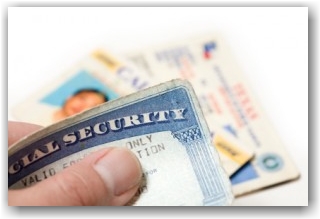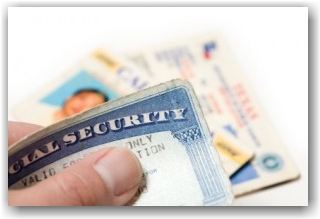Archive for the ‘Social Security’ Category
Monday, January 14th, 2019

Government enforcement activities at businesses significantly increased in 2018 and are anticipated to continue in 2019. The Immigration and Customs Enforcement (ICE) division of the Department of Homeland Security (DHS) conducted close to 6,000 audits last year compared to 1,360 audits in 2017. This is consistent with the Trump administration’s focus on immigration enforcement, and it will continue this year.
The whole purpose of the I-9 form is to ensure that you are hiring a legal workforce. In this article we will unpack Section 3 of the I-9 form, and offer some guidelines that will help you navigate when you must use this part of the form.
Employers must complete Section 3 of the I-9 Form when:
- Your employee’s employment authorization or documentation of employment authorization has expired.
- Your employee is rehired within 3 years of the date that Form I-9 was originally completed.
- Your employee has a legal name change.
When completing Section 3, you must also complete the last name, first name and middle initial fields in the Employee Info from Section 1 area at the top of Section 2.
When your employee’s employment authorization or, in most cases, employment authorization documentation (see below for more information) expires, you must reverify to ensure your employee is still authorized to work. To find out if your employee’s employment authorization expires, look in Section 1 for the date that employment authorization expires and in Section 2 for the date that the employment authorization document expires.
The employment authorization expiration date provided by your employee in Section 1 may not match the document expiration date recorded under List A or List C in Section 2. The earlier date must be used to determine when reverification is necessary.
We suggest that you remind employees, at least 90 days before the date reverification is required, that they will be required to present a List A or List C document (or acceptable receipt) showing continued employment authorization on the date that their employment authorization or documentation whichever is sooner, expires. If your employee has a Form I-765, Application for Employment Authorization, pending with USCIS, and the application has been pending for 75 days, your employee may call the USCIS Contact Center or schedule an InfoPass appointment at a local office to request expedited processing.
Employers should not reverify:
- U.S. citizens and non-citizen nationals
- Lawful permanent residents who presented a Form I-551, Permanent Resident or Alien Registration Receipt card for Section 2. This includes conditional residents.
- List B documents
Unless reverification does not apply (for the situations stated above), then when your employee’s employment authorization or employment authorization documentation expires your employee must present unexpired documents from either List A or List C showing authorization to work. Receipts for a lost, stolen or damaged document are acceptable for reverification.TEmployers should not reverify:
To complete Section 3, you must:
- Examine the unexpired documents to determine if they appear to be genuine and to relate to your employee. If you feel the document does not reasonably appear to be genuine and relate to your employee, allow your employee to present other documentation from the List of Acceptable Documents.
- Record the document title, document number and expiration date, if any.
- Sign and date Section 3.
If you previously completed Section 3, or if the version of the form you used for a previous verification is no longer valid, you must complete Section 3 of a new Form I-9 using the most current version and attach it to the previously completed Form I-9.
Rehires
If you rehire your employee within 3 years of the date that a previous Form I-9 was completed, you may either complete a new Form I-9 for your employee or complete Section 3 of the previously completed Form I-9.
To complete Section 3 for rehires, you must:
- Confirm that the original Form I-9 relates to your employee.
- Review the original Form I-9 to determine if your employee is still authorized to work, including whether employment authorization documentation presented in Section 2 (List A or List C) has since expired (or have been auto-extended). Use the guidelines to determine if reverification applies.
- If your employee is still authorized to work and his or her employment authorization documentation is still valid, enter the date of the rehire in the space provided in Section 3.
- If your employee is no longer authorized to work or the employment authorization documentation has since expired and requires reverification, request that the employee present an unexpired List A or List C document. Do not reverify an employee’s List B (identity) document. Enter the document information and the date of rehire in the spaces provided in Section 3. If the current version of Form I-9 is different from the previously completed Form I-9, you must complete Section 3 on the current version.
- Sign and date Section 3.
Entering Dates in Section 3
Section 3 includes three spaces to enter dates:
- If you rehire a former employee: enter the rehire date that your employee begins employment for wages or other remuneration, which can be a future date, if necessary, in Block B.
- If you reverify your employee: enter the date the employee’s new work authorization document expires in Block C.
- When completing Section 3 for any reason: enter the date you complete and sign the attestation.
Recording Changes of Name and Other Identity Information for Current Employees
You are not required to update Form I-9 when your employee has a legal change of name. However, it is recommended that you maintain correct information on Forms I-9 and note any name changes in Section 3. Although Form I-9 regulations do not require employees to present documentation to show that they have changed their name, you should take steps to be reasonably assured of your employee’s identity if there has been a legal name change. Such a change may call into question your continued ability to rely on the documents your employee previously presented, as they reasonably relate to the employee. These steps may include asking the employee to provide documentation of a legal change of name to keep with his or her Form I-9, so that your actions are well-documented if the government asks to inspect this employee’s Forms I-9.
You may encounter situations other than a legal change of name where an employee informs you that his or her identity is different from the time Form I-9 was previously completed. If your employee informs you that the name, date of birth, or Social Security number is substantially different from what he or she previously provided on Form I-9, and is unable to provide evidence linking the new information to the identity previously used you should:
- Complete a new Form I-9
- Write the original hire date in “The employee’s first day of employment (MM/DD/YYYY)” space in Section 2; and
- Attach the new Form I-9 to the previously completed Form I-9
- If the Section 1 information has not substantially changed but the employee has offered different evidence of work authorization, then you should examine the documentation to determine if it appears to be genuine and to relate to your employee presenting it. If so, complete Section 3 of the previous Form I-9. If the current version of Form I-9 is different from the previously completed Form I-9, you must complete Section 3 on the current version
For more information: Handbook for Employers
Online Learning Resources
Contact our office; we are experts in I-9 Consulting and Audits or call 562 612.3996.
Tags: E-Verify, Employer Compliance, Employment Reverification, I-9 Form, I-9 form Rehires, I-9/E-Verify News, Immigration News, Legal Workforce
Posted in Employer Compliance, I-9/E-Verify News, Immigration News, Social Security, USCIS | Comments Off on I-9 Form – When and How to Reverify Employees
Thursday, April 14th, 2016

The OSC publishes responses to TAL Letters (Technical Assistance Letters) that they receive from attorneys, employers and other stakeholders. USCIS identifies this circumstance in the I-9 Employer Handbook as an employee who comes forward and indicates that their identity is now different than previously represented (Hmm…) and now wants to “regularize” their employment record. Or, what do you do if you become aware, for instance, that a social security number associated with a particular employee was not legally assigned?
Discussion starts on page 2.
OSC’s TAL implies that if an employer has not consistently-followed a policy of terminating individuals for providing false information during the hiring process, it couldn’t use that policy to justify a termination in this particular scenario. Even if the employer did consistently terminate individuals who were dishonest during the hiring process, OSC implied that this was not necessarily a slam dunk argument either. It is important to note that OSC did not commit itself by concluding that such a termination under the circumstances would not constitute discrimination or be deemed to be a valid legitimate non-discriminatory reason for termination. It simply stated it would depend on the facts and circumstances. Before you go down this road, remember –the USCIS Handbook for Employers provides that “Where an employee has worked for you using a false identity but is currently work authorized, the I-9 rules do not require termination of employment.”
There’s also guidance regarding this for DACA employees that you might wish to review. For more on I-9 compliance please refer to our Employer Resource Center
Tags: E-Verify, I-9 Compliance, I-9 Form, I-9/E-Verify News, ICE, Legal Workforce, Social Security, USCIS
Posted in DACA | DAPA, Department Of Labor (DOL), Employer Compliance, I-9/E-Verify News, ICE, OSC, Social Security | Comments Off on Employee Notifies that I-9 Documents Previously Submitted were not Genuine: What’s an Employer to do?
Monday, August 24th, 2015
The new rule provides SSA and the public with different options for verifying an applicant’s identity and other eligibility factors, noting that it will continue to require the same evidence to establish citizenship, age and identity. The new rule will also remove the requirement that individuals seeking a replacement SSN card file an SS-5 form, allowing them instead to complete a “prescribed application,” which the agency said would simply be the application form — whether paper, online or another efficient, user friendly method. Additionally, the SSA will release, through a gradual, state-by-state rollout, an online application that will permit adult U.S. citizens who are not reporting any changes to their record to apply for replacement SSN cards electronically after registering through the “my Social Security” portal.
How will this change procedures for processing the I-9 Employment Eligibility Verification Form? The article states that employers are likely to find more rapid turnaround should employees lack a lost or misplaced social security card requiring reissuance. USCIS Form I-9 permits employers to initiate employment, in most instances, if hired employees can verify within three (3) days employment eligibility through the documentary requirements of USCIS Form I-9, including presentation of a valid social security card under “List C” of Form I-9.
::::::::
Immigration Compliance Group provides US inbound visa services to individuals and employers throughout the USA and abroad. We specialize in business immigration and have a depth of experience in the IT, healthcare, arts, entertainment and sports industries, amongst others. Our services include complex business visas for investors, multinational managers, skilled professionals, outstanding individuals of high achievement and PERM Labor Certification. We additionally provide employer compliance consulting services on proper I-9 (Employment Eligibility Verification) management, auditing, training, and work with our clients to develop a culture of immigration compliance.
Tags: Employer Compliance, Employment Verification, I-9 AUDIT, I-9 Form, I-9/E-Verify News, ICE, Legal Workforce, Social Security Card, SSA, USCIS
Posted in DACA | DAPA, Employer Compliance, I-9/E-Verify News, Social Security, USCIS | Comments Off on New Social Security Card Process to Commence Sept 9, 2015
Sunday, August 9th, 2015
 We’re starting to intake alot of questions concerning these cards as they now filter through the system to employers charged with handling Form I-9 employment verification.
We’re starting to intake alot of questions concerning these cards as they now filter through the system to employers charged with handling Form I-9 employment verification.
Twelve states and the District of Columbia enacted laws to allow unauthorized immigrants to obtain a driver’s licenses. These states—California, Colorado, Connecticut, Delaware, Hawaii, Illinois, Maryland, New Mexico, Nevada, Utah, Vermont and Washington—issue a license if an applicant provides certain documentation, such as a foreign birth certificate, a foreign passport, or a consular card and evidence of current residency in the state. Eight of these states extended driving privileges in 2013. In 2015, Delaware and Hawaii enacted legislation to give unauthorized immigrants driving privileges.
Here are examples of some of the cards with various different annotations.
An employer is required to accept as a list B document an unexpired driver’s license or ID that meets the standard for I-9 purposes. What’s the standard? A photo and other identifying information such as, their name, date of birth, gender, height, eye color and address. The underlying issue here is state law vs. immigration (federal law) and USCIS regulations concerning Form I-9.
Both USCIS and OSC concur, despite the various different types of annotations that appear on driver authorization cards, that they meet the regulations for an acceptable List B document if they adhere to the standards mentioned above.
An employer is required to examine the documents presented by its employee and determine whether they meet Form I-9 requirements. If the employer accepts any document, including a state-issued license or driver authorization card, or other type of ID with a limiting notation as a List B document, the employer must also examine a List C document that evidences employment authorization in order to make a proper determination if the individual is eligible for employment.
Employers may reject a document if it does not reasonably appear to be genuine or to relate to the employee. Rejecting a document that satisfies Form I-9 requirements may constitute illegal discrimination under the Immigration and Nationality Act’s anti-discrimination provision or Title VII of the Civil Rights Act of 1964.
USCIS has published a set of
FAQs on this topic that contain critical information and should be read, discussed and made a part of your training program for those charged with processing I-9 forms. Should you have any questions on this matter or any other concerns regarding employer compliance issues, please feel free to contact us at
info@immigrationcompliancegroup.com or call
562 612.3996.
Tags: Driver Authorization Cards, Driver's License, Employer Compliance, I-9 Form, I-9/E-Verify News, ID Cards, ID Cards for Undocumented Immigrants, Immigration News, Legal Workforce, List B Documents
Posted in Employer Compliance, I-9/E-Verify News, ICE, Immigration News, OSC, Social Security, USCIS | Comments Off on Can Driver Authorization Cards be used as a List B Document for I-9 Employment Verification?
Saturday, June 20th, 2015
 Since early 2015, qualified California residents have been able to apply for and receive a driver’s license issued by the Department of Motor Vehicles without proving that their presence in the United States is authorized under federal law. All employers must accept the AB 60 driver’s license as a Form I-9 List B Identity document if the license reasonably appears to be genuine and to relate to the individual. As with all permissible List B driver’s licenses, the AB 60 driver’s license must contain either a photograph or list the individual’s name, date of birth, gender, height, eye color, and address. The AB 60 driver’s license only documents the employee’s identity; California employers must still examine a List C document that establishes employment authorization, such as a Social Security card or birth certificate.
Since early 2015, qualified California residents have been able to apply for and receive a driver’s license issued by the Department of Motor Vehicles without proving that their presence in the United States is authorized under federal law. All employers must accept the AB 60 driver’s license as a Form I-9 List B Identity document if the license reasonably appears to be genuine and to relate to the individual. As with all permissible List B driver’s licenses, the AB 60 driver’s license must contain either a photograph or list the individual’s name, date of birth, gender, height, eye color, and address. The AB 60 driver’s license only documents the employee’s identity; California employers must still examine a List C document that establishes employment authorization, such as a Social Security card or birth certificate.
View the Example of the AB-CA Driver’s License annotated with “Federal Benefits Apply”.
Tags: CA AB-60 Driver's License, DACA, Department Of Homeland Security (DHS), Employer Compliance, EMPLOYMENT ELIGIBILITY, I-9 Form, I-9/E-Verify News, ICE, Immigration News, Legal Workforce, OSC, Social Security, USCIS
Posted in DACA | DAPA, Employer Compliance, I-9/E-Verify News, ICE, Immigration Legislation, Immigration News, OSC, Social Security, USCIS | Comments Off on California New AB 60 Driver’s License: Is it Good for Employment Eligibility?
Sunday, January 5th, 2014
 DHS/ICE continues to issue Notices of Intent to Fine (NOFs) at an unprecedented rate for Form I-9 related infractions. Mistakes occur in the I-9 process, it’s inevitable. While establishing a written compliance policy, training and careful prevention is the best approach. All employers should take time at the beginning of each year to conduct an internal audit and self-examination of their systems, operating procedures, and past and present practices for handling I-9s, as well as to access training needs for the employees charged with handling and supervising the I-9 process. We also recommend that you review your E-Verify submissions, as well as revisiting just how compliant your I-9 software really is with your vendor if you are using an electronic system.
DHS/ICE continues to issue Notices of Intent to Fine (NOFs) at an unprecedented rate for Form I-9 related infractions. Mistakes occur in the I-9 process, it’s inevitable. While establishing a written compliance policy, training and careful prevention is the best approach. All employers should take time at the beginning of each year to conduct an internal audit and self-examination of their systems, operating procedures, and past and present practices for handling I-9s, as well as to access training needs for the employees charged with handling and supervising the I-9 process. We also recommend that you review your E-Verify submissions, as well as revisiting just how compliant your I-9 software really is with your vendor if you are using an electronic system.
While there are many checklists and do-it-yourself guides and webinars available on the Internet and elsewhere, consulting a licensed attorney or specialist in the field who is familiar with I-9 and E-Verify compliance issues can save employers hours of research, provide a solution tailored to your organization, and save you thousands of dollars in fines and penalties should ICE knock on your door.
When ICE notifies an employer of their intention to perform an audit, it opens the door for an onslaught of inquiries and investigation from other government agencies that range from SSA mis-match issues to Department of Labor (DOL) wage and hour, USCIS, IRS, and more if you have areas of incompliance in your operating procedures. This is not the time during an audit when under pressure to clean up compliance problems.
New employers are often more at risk because many are not even aware of the I-9 requirement, and probably are also unaware of the need for all employees to complete the I-9 Form. Some are aware, but they lack knowledge concerning the regulations that govern the form; such as, timeframes, acceptable documents, form retention, and other important details that are integral to the process. Particularly, there are problems with industries such as IT consulting, healthcare, staffing agencies, and other organizations with multiple locations in regard to completing the I-9-Form remotely with the employer’s designated agent and employee in different locations.
These are just a few reasons why we urge you to assess the strengths and weaknesses of your present compliance program, and start the New Year fresh with a renewed commitment to implement best practices that will provide the foundation upon which you can develop and maintain a more compliant business and workforce.
You might be interested in joining our LinkedIn group, I-9/E-Verify: Smart Solutions for Employers,” and signing up to receive via RSS feed or email our Blog posts.
Tags: +, Department Of Homeland Security (DHS), DOL, E-Verify, I-9 AUDIT, I-9 Best Practices, I-9 Comipliance, I-9 Form, I-9 Training, I-9/E-Verify News, ICE, Immigration News, Legal Workforce, OSC, SSA
Posted in Department Of Homeland Security (DHS), Department Of Labor (DOL), Employer Compliance, Healthcare, I-9/E-Verify News, ICE, Immigration News, OSC, Social Security, Staffing Agencies, USCIS | Comments Off on Compliance Audits are Recommended for Employers at the Beginning of the New Year
Friday, November 29th, 2013
 On December 8, 2013 E-Verify will release new and revised Memorandums of Understanding (MOUs) that are tailored to each access method.
On December 8, 2013 E-Verify will release new and revised Memorandums of Understanding (MOUs) that are tailored to each access method.
The changes were made in response to customer feedback and to update the MOUs with policy and process changes. Users will find that the new versions have more plain language and are easier to understand, with new titles that clearly identify the access method to which the MOU applies, and bullets that have been changed to letters and numbers to make searching and citation easier. Also, the lengthy sections have been broken up.
Please take the time to review and become familiar with the new MOU’s that apply to your access method; refer to the Fact Sheet and the preview of the new MOUs here. You can also access this information under “View Essential Resources” by logging into E-Verify to review the new and revised MOUs.
What you need to know
- Current E-Verify users will not be required to execute a new MOU, but are bound by any and all enhancements to the E-Verify program including the new or revised MOUs that apply to their access method. Current users should become familiar with the new or revised MOU that applies to them. The effective date of the MOU for existing users is January 8, 2014.
- The E-Verify enrollment process has not changed. New Users will review and execute the new or revised version of the MOU that applies to their access method during enrollment. The effective date of the MOU for new users is December 8, 2013.
- The new and revised MOUs include several updated provisions such as enhanced privacy protections and instructions for reporting privacy and security breaches.
Revised Memorandums of Understanding
TeleConferences
Two teleconferences will be hosted by USCIS to introduce and discuss the revisions schedule as follows:
1) For General Audience: December 11(Wed.) 2:30 – 3:30 EST. Will discuss the revisions made to the existing MOU’s and will open up for Questions. Register here
2) For E-Verify Users: December 12 (Thurs.), 2:30 – 3:30 EST. USCIS officials will provide an overview of the three new MOUs for Web service participants, and be available to answer questions. Register here
If you have any questions regarding the registration process, or if you have not received confirmation email within two business days, please email us at Public.Engagement@uscis.dhs.gov.
Tags: Department Of Homeland Security (DHS), E-Verify, E-Verify MOU, Employment Eligibility Verification, I-9 Form, I-9/E-Verify News, I-9/E-Verify News, ICE, Immigration News, Legal Workforce, SSA, USCIS
Posted in Employer Compliance, I-9/E-Verify News, ICE, Immigration News, Social Security, USCIS | Comments Off on E-Verify Update —–New/Revised MOU’s Released
Monday, November 11th, 2013

While DHS/ICE continues to issue Notices of Intent to Fine (NOFs) at an unprecedented rate for Form I-9 related infractions, this is yet another reminder that you can choose to pay the fine or you can contest the fine and file for a hearing (within 30 days of receipt of the NOF) before an Administrative Law Judge (ALJ) who handles cases related to employer sanctions, document fraud and unfair immigration-related employment practices. OCAHO has more than proven that they are willing to reassess and lower fees in just about every case in recent months.
Note that many employer sanctions cases never proceed to the hearing stage because either the parties reach a settlement with the approval of the ALJ, or the ALJ resolves a case through a prehearing ruling.
We recommend that your first step in the process be to retain experienced representation that specializes in the practice area of employer compliance to guide you step by step through the process – don’t attempt to go this alone. The next step is to understand the process that has been summarized very efficiently in the recent Fact Sheet that we refer to here
Should you have any questions or wish to become a client of our office, please contact us or refer to our services & solutions page.
Tags: ALJ I-9 Hearing, Department Of Homeland Security (DHS), Document Fraud, DOL, Employer Sanctions, I-9 Fees, I-9 Form, I-9/E-Verify News, ICE Audit, ICE Investigation, Immigration News, IRCA, Legal Workforce, Notice of Intent to Fine, OCAHO, OSC, SSA
Posted in DOJ, Employer Compliance, Federal Contractors, I-9/E-Verify News, ICE, Immigration News, OSC, Social Security | Comments Off on How to Contest an I-9 Notice of Intent to Fine (NOF)
Thursday, October 31st, 2013

Infosys is India’s second largest software exporter, and has about 30,000 workers in the U.S. (160,000 worldwide) with $6B in sales.
After years of investigation, it was found that Infosys “knowingly and unlawfully” brought Indian workers into the United States on B-1 business visitor visas( since 2008), to circumvent the higher costs and delays of a longer-term employment-related visa, such as the H-1B visa that the workers should have had. It was found that Infosys systematically submitted misleading information to US immigration authorities and consular officials to obtain the B-1 visas that do not permit employment, unfairly gaining a competitive edge and undercutting American workers qualified for the jobs
Press release states: “Infosys failed to maintain I-9 records for many of its foreign nationals in the United States in 2010 and 2011 as required by law, including a widespread failure to update and re-verify the employment authorization status of a large percentage of its foreign national employees…more than 80 percent of Infosys’s I-9 forms for 2010 and 2011 contained substantive violations.”
The largest fine of its kind, was paid out as follows: $5 million to Homeland Security Investigations, $5 million to the Department of State, and $24 million to the DOJ.
How can employers protect themselves?
The five federal agencies charged with workplace enforcement are not only going after businesses that are known to employ undocumented workers, but they are also making examples out of industry leaders across the country creating headline news. It goes without saying, that this is now a topic that should be on HR executives’ action list. Turning a blind eye can be exceedingly costly and cause great damage to a company’s reputation.
For more on this Story: CBS Reports NY Times
For more on our services and solutions
Tags: B-1 Visa, Business Immigration, DOL, H-1B Visa, HSI, I-9 Violations, I-9/E-Verify News, ICE Audit, ICE Investigation, ICE NOI, Indian IT Industry, Infosys, Legal Workforce, Skilled Professionals, Specialty Workers, SSA, US Consulates, USCIS, Visa Fraud
Posted in Department Of Homeland Security (DHS), Department Of Labor (DOL), Department of State, Employer Compliance, H-1B Visas, I-9/E-Verify News, ICE, Immigration News, Social Security, USCIS | Comments Off on Infosys to pay $34M in Fines for Visa Fraud and I-9 Violations
Thursday, October 24th, 2013
 We have written many articles over the years on what happens when ICE serves an employer with a Notice of Inspection (NOI); see below for links to our articles and resources. Today, ICE released a new Fact Sheet that referrences the IRCA law in the 1st paragraph, and then summarizes the order in which an ICE administrative inspection proceeds, the types of notices that are issued following an I-9 ICE audit, how fines are determined based upon knowingly hiring and continuing to employ violations, to substantive and uncorrected techical violations, and how these fines and penalties are calculated.
We have written many articles over the years on what happens when ICE serves an employer with a Notice of Inspection (NOI); see below for links to our articles and resources. Today, ICE released a new Fact Sheet that referrences the IRCA law in the 1st paragraph, and then summarizes the order in which an ICE administrative inspection proceeds, the types of notices that are issued following an I-9 ICE audit, how fines are determined based upon knowingly hiring and continuing to employ violations, to substantive and uncorrected techical violations, and how these fines and penalties are calculated.
The penalties for ignoring the legal requirements of the I-9 process can be quite severe, even in cases of unintentional omissions and uncorrected I-9 mistakes. Civil penalties for such errors may range from $110 to $1,100 for each effected employee. A business with thousands of employees and multiple worksites may face a significant financial burden in noncompliance penalties. The fines may be further increased if ICE determines that an employer knowingly hired unauthorized foreign nationals, and can range from $375 to $16,000 per violation with repeat offenders on the high end. Employers and their representatives convicted of having engaged in a pattern or practice of knowingly hiring unauthorized foreign nationals, may also face criminal charges and fines of up to $3,000 per employee and/or six months’ imprisonment. Other federal criminal statues may provide higher penalties in certain fraud cases.
Employers and individuals who commit citizenship status or national origin discrimination may be ordered to pay civil fines and attorneys’ fees. The penalties range from $375 to $3,200 for the first offense for each individual discriminated against; from $3,200 to $6,500 for the second offense; and for subsequent offenses, not less than $4,300 and not more than $16,000 for each person effected.
The trend toward increased scrutiny of immigration employment practices will likely continue in the foreseeable future. With immigration reform still uncertain, ICE continues to step up enforcement activities with a deluge of NOI’s to employers every few months. These recent developments have made it even more critical that employers maintain a strong immigration compliance profile. Employers can no longer afford to think that because they don’t hire foreign nationals, they don’t have any I-9 issues or need to comply with I-9 immigration regulations.
The key to I-9 compliance for most organizations starts with a thorough self-examination of existing paper I-9’s, E-Verify submissions (if applicable), standard operating procedures, and past practices. While there are many checklists and do-it-yourself guides, free webinars and Podcasts available on the Internet and elsewhere, consulting an experienced immigration consultant or attorney in the practice area can save employers hours of research, provide a solution tailored to your organization and save you thousands of dollars in fines and penalties.
You should strongly consider an independent I-9 audit if…
- You’ve had a turnover in the HR position(s) charged with the responsibility of handling and processing I-9 Forms
- None of the staff charged with the I-9 process has been formally trained
- You already know that you have I-9 document violations, errors and unintentional mistakes
- You have recently gone through a corporate reorganization, merger or acquisition
- You know you have an on-boarding process that is complex, such as multiple jobsite locations where the I-9 process takes place
- When you haven’t documented your I-9 Form policies and procedures in a policy statement or procedures manual
- If you have a large volume of foreign worker I-9 forms
- If you do not have a calendar system for re-verification or terminated employee retention
- If you do not have a centralized I-9 recordkeeping process
- If you are photocopying documents presented during the I-9 process for some and not for others
- You participate in government contracts and have been asked to perform an I-9 audit
- You have not performed a random or full audit within the last year by either an internal individual who is familiar with I-9 compliance rules but does not deal with I-9s on a regular basis, or by a reputable independent I-9 auditor.
- You’ve never performed a self-audit or had any outside provider perform an I-9 audit
- You do not know how to make corrections to the I-9 form
- You’ve received SSA No Match Letters
- Your industry is being targeted by ICE
- You’re unaware that a new I-9 form was released and do not have a process in place for staying current with regulations and procedures
Immigration Compliance Group regularly represents clients from all industries to develop effective I-9 policies and compliance programs. By establishing and maintaining effective corporate policies and procedures, many of the above-mentioned warning signs can be addressed proactively in an audit before the government does one for you.
New ICE Fact Sheet
I-9Audit.com – Our Employer Resource Center Articles
Tags: Department Of Homeland Security (DHS), I-9 AUDIT, I-9 Compliance, I-9 News, I-9 Training, I-9/E-Verify, I-9/E-Verify News, ICE, ICE Audit, ICE Fines, ICE Inspection Fact Sheet, ICE Penalties, Immigration News, Legal Workforce, NOI, Notice of Inspection, OSC, SSA
Posted in Department Of Homeland Security (DHS), Employer Compliance, Federal Contractors, I-9/E-Verify News, ICE, Immigration News, OSC, Social Security | Comments Off on ICE Releases New Fact Sheet on the I-9 Inspection Process






